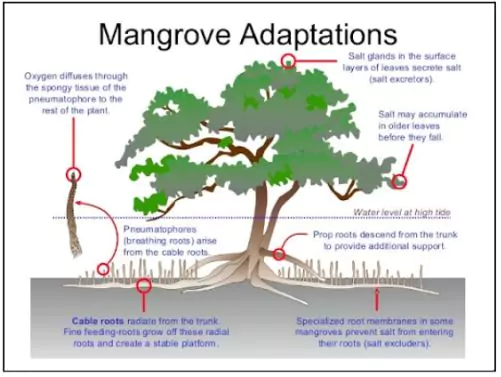Amid rising seas and extreme weather, mangroves emerge as vital climate buffers and economic drivers, yet remain undervalued in policy and business strategies.
What are Mangroves?

- Mangroves are salt-tolerant trees and shrubs found in coastal intertidal zones, where freshwater and seawater mix.
- They grow in tropical and subtropical climates with high rainfall (1,000–3,000 mm) and temperatures between 26–35°C.
- Common Species: Rhizophora species (Red mangrove), Sundari (Heritiera fomes), Avicennia marina (grey mangrove) and Sonneratia apetala (Keora ) are commonly found in India.
Key Roles of Mangroves in India’s Coastal Economy
- Natural Infrastructure: Act as storm barriers, reducing damage to urban coastlines and infrastructure.
- Fisheries Backbone: Serve as nurseries for juvenile fish, sustaining marine biodiversity and coastal livelihoods.
- Blue Carbon Reservoirs: Sequester significant carbon, with Sundarbans alone valued at ₹462 million annually for carbon services.
- Ecosystem Services: Offer billions in avoided damages and services ranging from ₹3,535 million in Pichavaram (Tamil Nadu) to ₹664 billion in the Sundarbans (West Bengal).
- Livelihood Multipliers: Enable aquaculture, eco-tourism, and beekeeping, linking ecological health to income generation.
Ways to Enhance the Economic Role of Mangroves
- Harness Technology for Valuing Natural Capital: Use satellite, drone, and AI-based geospatial tools to map mangroves and quantify blue carbon.
- Integrate economic valuations into policy to prioritize conservation investments.
- Ensure Equitable Benefit Sharing: Recognize and reward traditional knowledge of local communities by guaranteeing social and economic benefits from restoration projects for those dependent on mangrove ecosystems.
- Strengthen Community-Led Stewardship: Promote fisherfolk partnerships to link healthy mangroves with sustainable fish stocks and food security.
- Adapt Eco-Development Committees (EDCs) and Joint Forest Management Committees (JFMCs) to urban settings for shared ownership.
- Revitalize Urban Mangroves: Address pollution and degradation in cities like Mumbai and Chennai by integrating mangrove restoration with urban planning to restore biodiversity and socio-cultural linkages.
- Expand Citizen Science and Engagement: Develop mangrove health tools to monitor area, freshwater flows, and biodiversity.
- Use initiatives like “Mangrove Mitras” to connect citizens with wetlands, enabling collective action and knowledge co-creation.
Conclusion
Mangrove conservation must be a coalition of science, business, and community voices, positioning these ecosystems as economic and climate infrastructure, not just biodiversity reserves.
Additional Readings: What are Mangroves?
![]() 2 Aug 2025
2 Aug 2025


